A Detailed Report on Corporate Accounting and Reporting of Leases
VerifiedAdded on 2023/06/05
|7
|1597
|378
Report
AI Summary
This report evaluates the treatment of leases from the lessee's perspective, emphasizing the importance of accurate record-keeping for financial transparency. It delves into AASB 16, which governs lease recognition, measurement, presentation, and disclosure. The report outlines the accounting process for both finance and operating leases, detailing how they impact the balance sheet, income statement, and cash flow statement. It provides a practical example with journal entries to illustrate the accounting treatment. Additionally, the report includes a computation of impairment loss, offering a comprehensive overview of lease accounting and reporting requirements under AASB guidelines. Desklib provides access to this and other solved assignments to aid students in their studies.
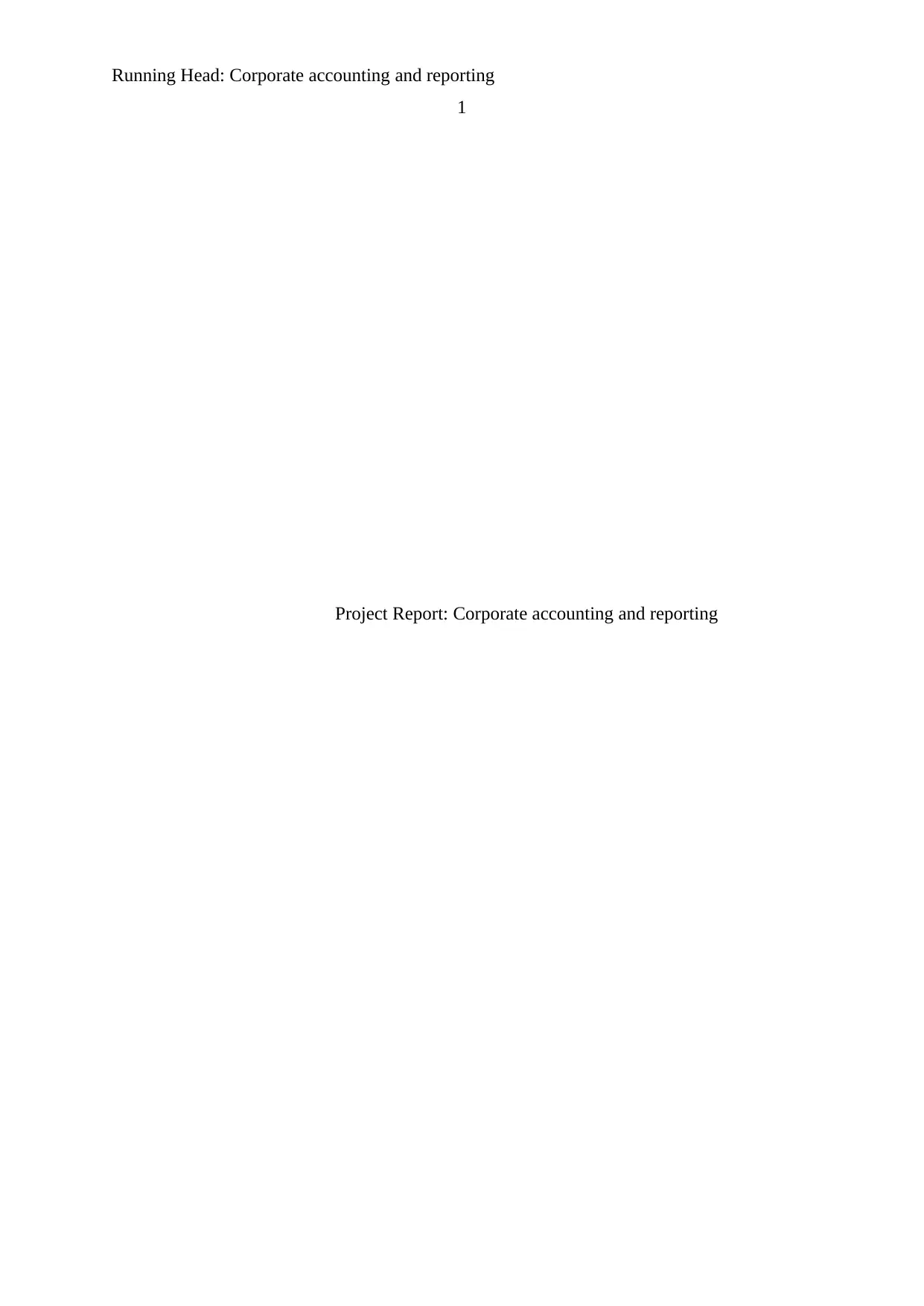
Running Head: Corporate accounting and reporting
1
Project Report: Corporate accounting and reporting
1
Project Report: Corporate accounting and reporting
Paraphrase This Document
Need a fresh take? Get an instant paraphrase of this document with our AI Paraphraser
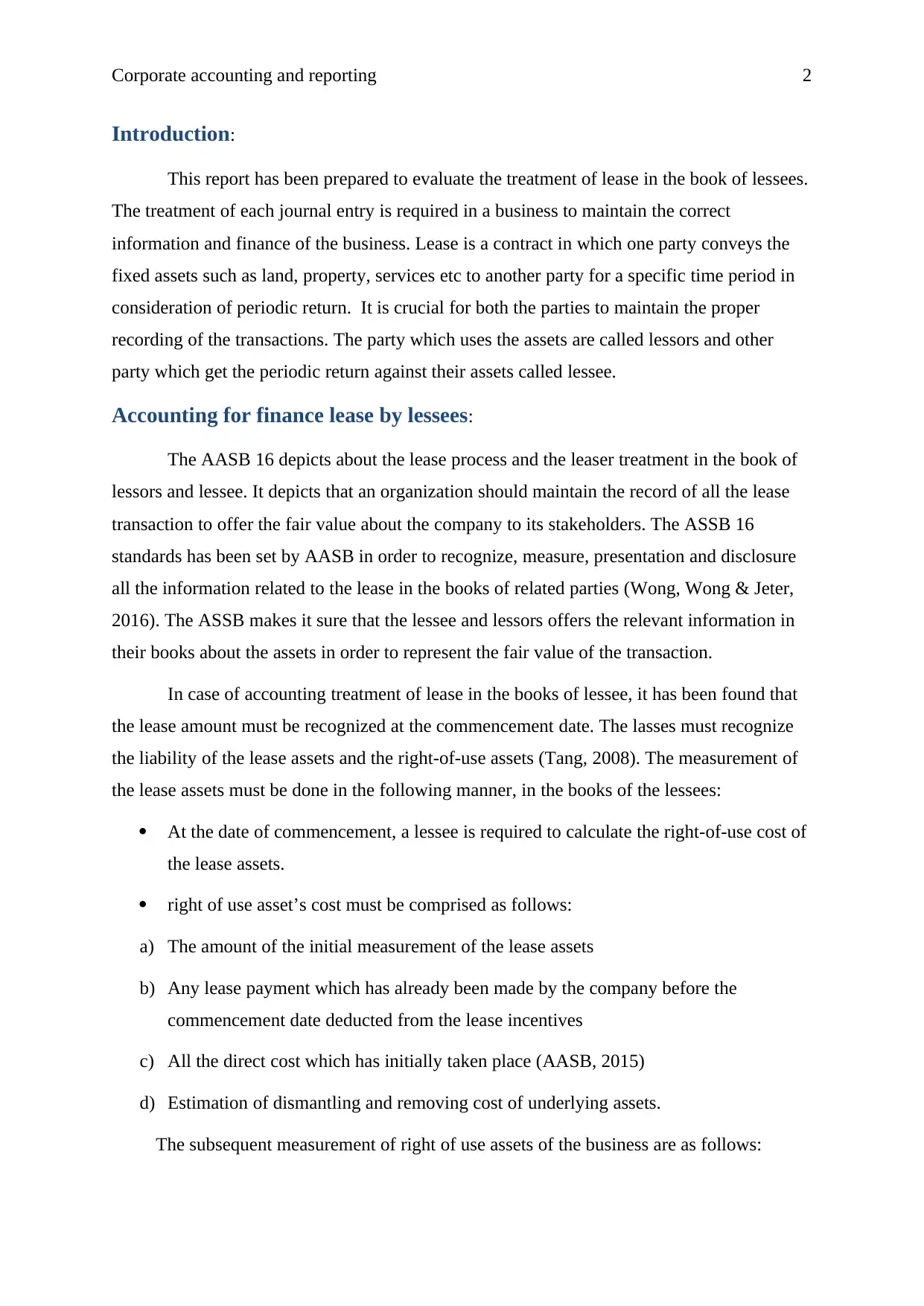
Corporate accounting and reporting 2
Introduction:
This report has been prepared to evaluate the treatment of lease in the book of lessees.
The treatment of each journal entry is required in a business to maintain the correct
information and finance of the business. Lease is a contract in which one party conveys the
fixed assets such as land, property, services etc to another party for a specific time period in
consideration of periodic return. It is crucial for both the parties to maintain the proper
recording of the transactions. The party which uses the assets are called lessors and other
party which get the periodic return against their assets called lessee.
Accounting for finance lease by lessees:
The AASB 16 depicts about the lease process and the leaser treatment in the book of
lessors and lessee. It depicts that an organization should maintain the record of all the lease
transaction to offer the fair value about the company to its stakeholders. The ASSB 16
standards has been set by AASB in order to recognize, measure, presentation and disclosure
all the information related to the lease in the books of related parties (Wong, Wong & Jeter,
2016). The ASSB makes it sure that the lessee and lessors offers the relevant information in
their books about the assets in order to represent the fair value of the transaction.
In case of accounting treatment of lease in the books of lessee, it has been found that
the lease amount must be recognized at the commencement date. The lasses must recognize
the liability of the lease assets and the right-of-use assets (Tang, 2008). The measurement of
the lease assets must be done in the following manner, in the books of the lessees:
At the date of commencement, a lessee is required to calculate the right-of-use cost of
the lease assets.
right of use asset’s cost must be comprised as follows:
a) The amount of the initial measurement of the lease assets
b) Any lease payment which has already been made by the company before the
commencement date deducted from the lease incentives
c) All the direct cost which has initially taken place (AASB, 2015)
d) Estimation of dismantling and removing cost of underlying assets.
The subsequent measurement of right of use assets of the business are as follows:
Introduction:
This report has been prepared to evaluate the treatment of lease in the book of lessees.
The treatment of each journal entry is required in a business to maintain the correct
information and finance of the business. Lease is a contract in which one party conveys the
fixed assets such as land, property, services etc to another party for a specific time period in
consideration of periodic return. It is crucial for both the parties to maintain the proper
recording of the transactions. The party which uses the assets are called lessors and other
party which get the periodic return against their assets called lessee.
Accounting for finance lease by lessees:
The AASB 16 depicts about the lease process and the leaser treatment in the book of
lessors and lessee. It depicts that an organization should maintain the record of all the lease
transaction to offer the fair value about the company to its stakeholders. The ASSB 16
standards has been set by AASB in order to recognize, measure, presentation and disclosure
all the information related to the lease in the books of related parties (Wong, Wong & Jeter,
2016). The ASSB makes it sure that the lessee and lessors offers the relevant information in
their books about the assets in order to represent the fair value of the transaction.
In case of accounting treatment of lease in the books of lessee, it has been found that
the lease amount must be recognized at the commencement date. The lasses must recognize
the liability of the lease assets and the right-of-use assets (Tang, 2008). The measurement of
the lease assets must be done in the following manner, in the books of the lessees:
At the date of commencement, a lessee is required to calculate the right-of-use cost of
the lease assets.
right of use asset’s cost must be comprised as follows:
a) The amount of the initial measurement of the lease assets
b) Any lease payment which has already been made by the company before the
commencement date deducted from the lease incentives
c) All the direct cost which has initially taken place (AASB, 2015)
d) Estimation of dismantling and removing cost of underlying assets.
The subsequent measurement of right of use assets of the business are as follows:
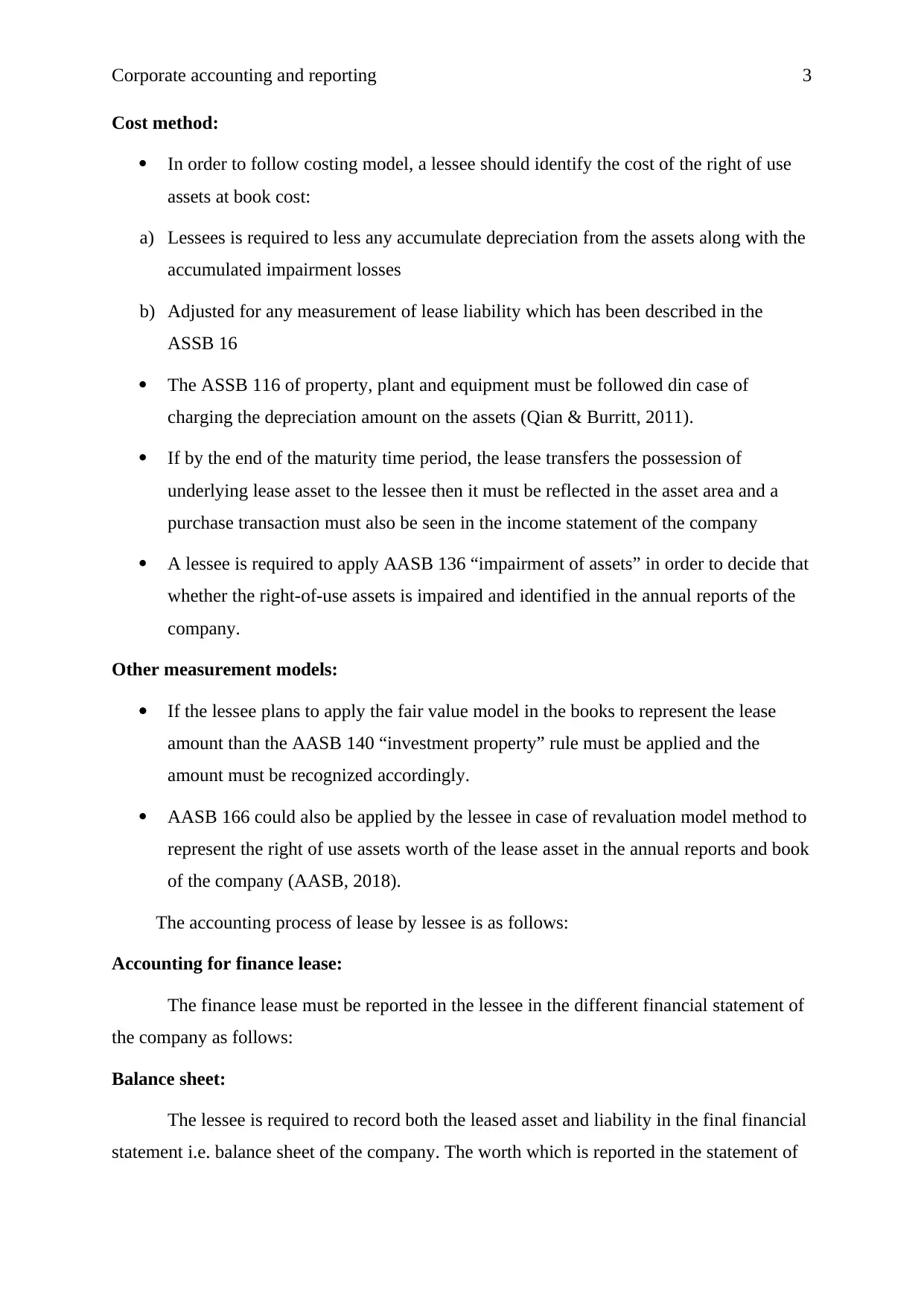
Corporate accounting and reporting 3
Cost method:
In order to follow costing model, a lessee should identify the cost of the right of use
assets at book cost:
a) Lessees is required to less any accumulate depreciation from the assets along with the
accumulated impairment losses
b) Adjusted for any measurement of lease liability which has been described in the
ASSB 16
The ASSB 116 of property, plant and equipment must be followed din case of
charging the depreciation amount on the assets (Qian & Burritt, 2011).
If by the end of the maturity time period, the lease transfers the possession of
underlying lease asset to the lessee then it must be reflected in the asset area and a
purchase transaction must also be seen in the income statement of the company
A lessee is required to apply AASB 136 “impairment of assets” in order to decide that
whether the right-of-use assets is impaired and identified in the annual reports of the
company.
Other measurement models:
If the lessee plans to apply the fair value model in the books to represent the lease
amount than the AASB 140 “investment property” rule must be applied and the
amount must be recognized accordingly.
AASB 166 could also be applied by the lessee in case of revaluation model method to
represent the right of use assets worth of the lease asset in the annual reports and book
of the company (AASB, 2018).
The accounting process of lease by lessee is as follows:
Accounting for finance lease:
The finance lease must be reported in the lessee in the different financial statement of
the company as follows:
Balance sheet:
The lessee is required to record both the leased asset and liability in the final financial
statement i.e. balance sheet of the company. The worth which is reported in the statement of
Cost method:
In order to follow costing model, a lessee should identify the cost of the right of use
assets at book cost:
a) Lessees is required to less any accumulate depreciation from the assets along with the
accumulated impairment losses
b) Adjusted for any measurement of lease liability which has been described in the
ASSB 16
The ASSB 116 of property, plant and equipment must be followed din case of
charging the depreciation amount on the assets (Qian & Burritt, 2011).
If by the end of the maturity time period, the lease transfers the possession of
underlying lease asset to the lessee then it must be reflected in the asset area and a
purchase transaction must also be seen in the income statement of the company
A lessee is required to apply AASB 136 “impairment of assets” in order to decide that
whether the right-of-use assets is impaired and identified in the annual reports of the
company.
Other measurement models:
If the lessee plans to apply the fair value model in the books to represent the lease
amount than the AASB 140 “investment property” rule must be applied and the
amount must be recognized accordingly.
AASB 166 could also be applied by the lessee in case of revaluation model method to
represent the right of use assets worth of the lease asset in the annual reports and book
of the company (AASB, 2018).
The accounting process of lease by lessee is as follows:
Accounting for finance lease:
The finance lease must be reported in the lessee in the different financial statement of
the company as follows:
Balance sheet:
The lessee is required to record both the leased asset and liability in the final financial
statement i.e. balance sheet of the company. The worth which is reported in the statement of
⊘ This is a preview!⊘
Do you want full access?
Subscribe today to unlock all pages.

Trusted by 1+ million students worldwide
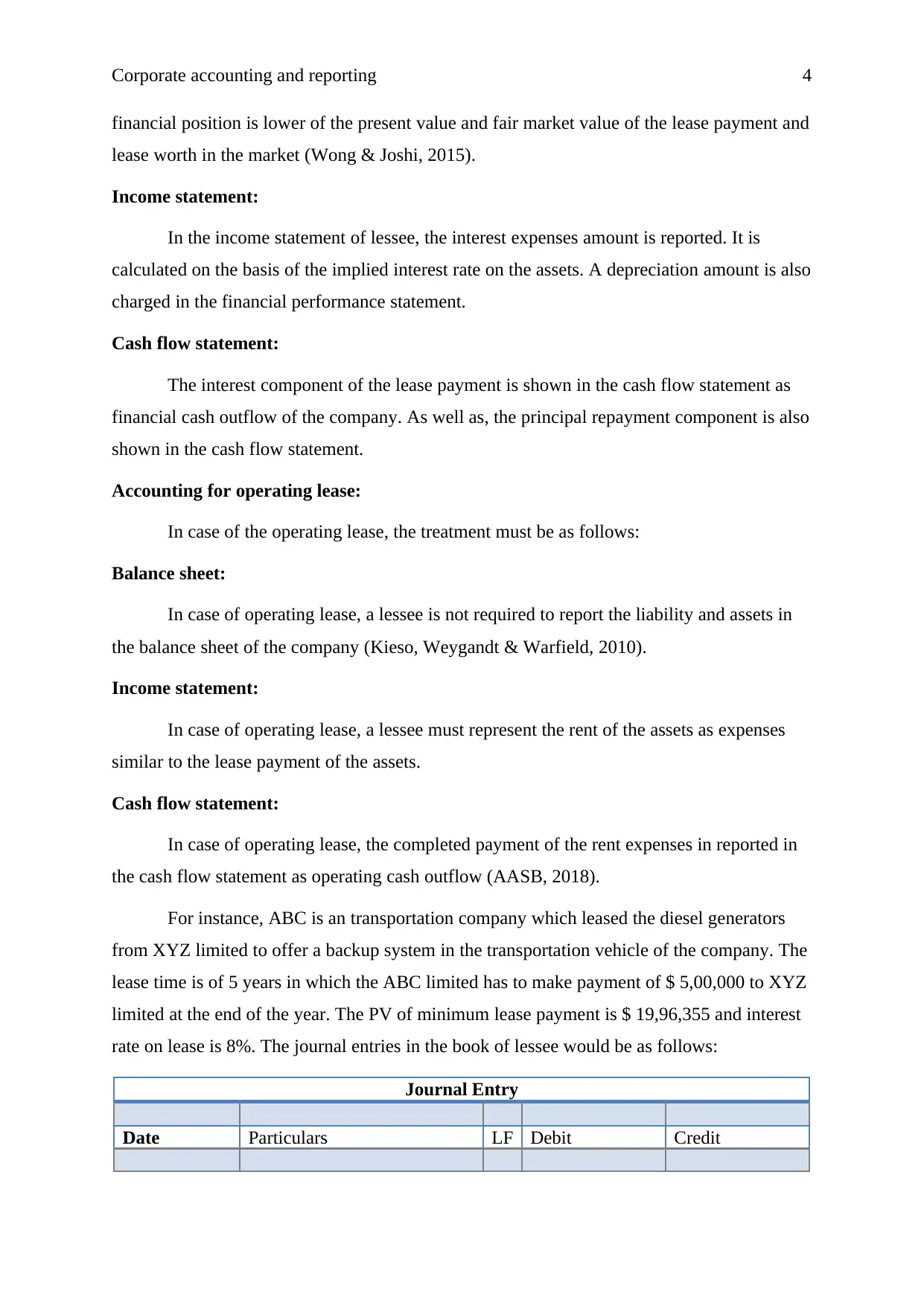
Corporate accounting and reporting 4
financial position is lower of the present value and fair market value of the lease payment and
lease worth in the market (Wong & Joshi, 2015).
Income statement:
In the income statement of lessee, the interest expenses amount is reported. It is
calculated on the basis of the implied interest rate on the assets. A depreciation amount is also
charged in the financial performance statement.
Cash flow statement:
The interest component of the lease payment is shown in the cash flow statement as
financial cash outflow of the company. As well as, the principal repayment component is also
shown in the cash flow statement.
Accounting for operating lease:
In case of the operating lease, the treatment must be as follows:
Balance sheet:
In case of operating lease, a lessee is not required to report the liability and assets in
the balance sheet of the company (Kieso, Weygandt & Warfield, 2010).
Income statement:
In case of operating lease, a lessee must represent the rent of the assets as expenses
similar to the lease payment of the assets.
Cash flow statement:
In case of operating lease, the completed payment of the rent expenses in reported in
the cash flow statement as operating cash outflow (AASB, 2018).
For instance, ABC is an transportation company which leased the diesel generators
from XYZ limited to offer a backup system in the transportation vehicle of the company. The
lease time is of 5 years in which the ABC limited has to make payment of $ 5,00,000 to XYZ
limited at the end of the year. The PV of minimum lease payment is $ 19,96,355 and interest
rate on lease is 8%. The journal entries in the book of lessee would be as follows:
Journal Entry
Date Particulars LF Debit Credit
financial position is lower of the present value and fair market value of the lease payment and
lease worth in the market (Wong & Joshi, 2015).
Income statement:
In the income statement of lessee, the interest expenses amount is reported. It is
calculated on the basis of the implied interest rate on the assets. A depreciation amount is also
charged in the financial performance statement.
Cash flow statement:
The interest component of the lease payment is shown in the cash flow statement as
financial cash outflow of the company. As well as, the principal repayment component is also
shown in the cash flow statement.
Accounting for operating lease:
In case of the operating lease, the treatment must be as follows:
Balance sheet:
In case of operating lease, a lessee is not required to report the liability and assets in
the balance sheet of the company (Kieso, Weygandt & Warfield, 2010).
Income statement:
In case of operating lease, a lessee must represent the rent of the assets as expenses
similar to the lease payment of the assets.
Cash flow statement:
In case of operating lease, the completed payment of the rent expenses in reported in
the cash flow statement as operating cash outflow (AASB, 2018).
For instance, ABC is an transportation company which leased the diesel generators
from XYZ limited to offer a backup system in the transportation vehicle of the company. The
lease time is of 5 years in which the ABC limited has to make payment of $ 5,00,000 to XYZ
limited at the end of the year. The PV of minimum lease payment is $ 19,96,355 and interest
rate on lease is 8%. The journal entries in the book of lessee would be as follows:
Journal Entry
Date Particulars LF Debit Credit
Paraphrase This Document
Need a fresh take? Get an instant paraphrase of this document with our AI Paraphraser
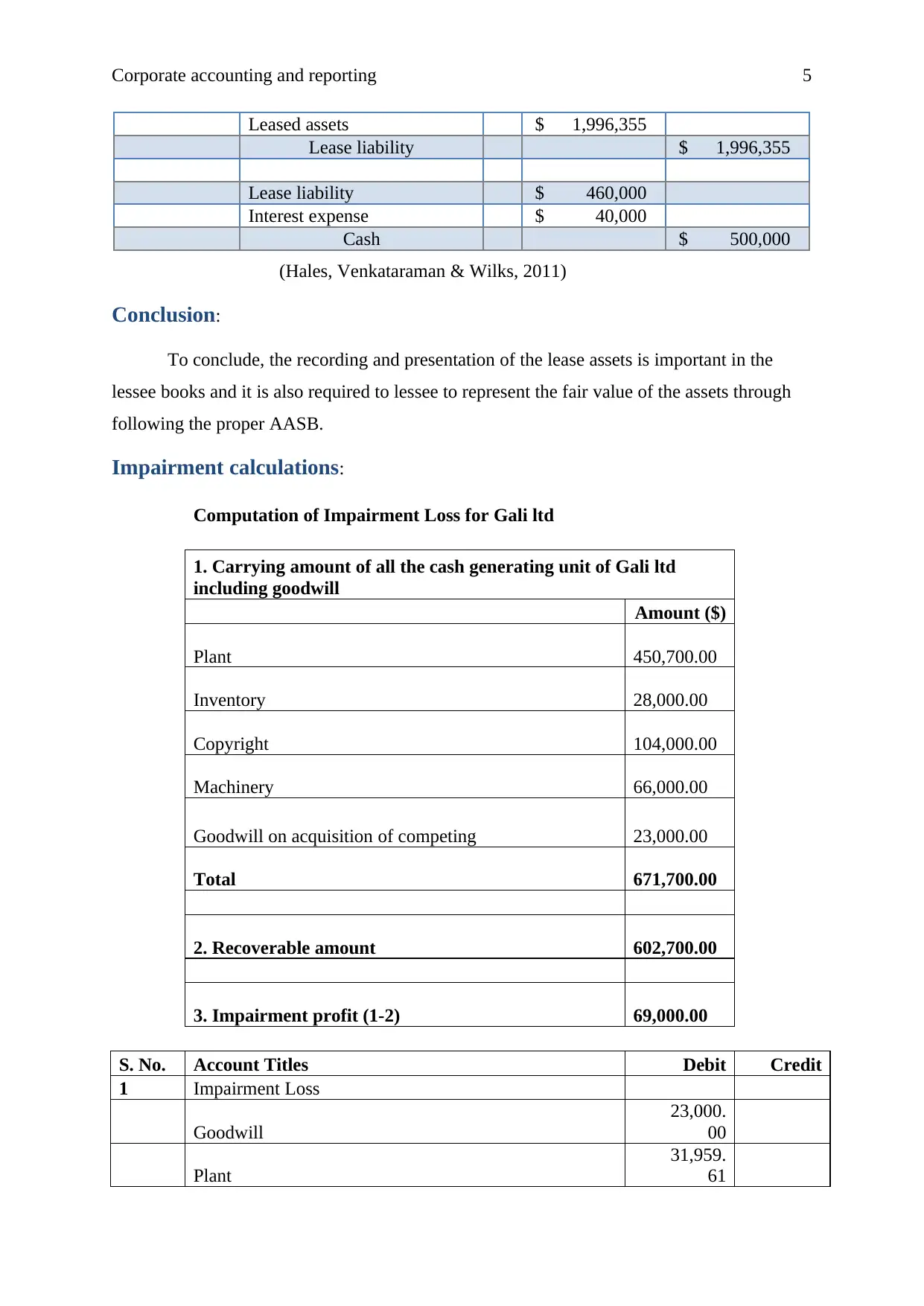
Corporate accounting and reporting 5
Leased assets $ 1,996,355
Lease liability $ 1,996,355
Lease liability $ 460,000
Interest expense $ 40,000
Cash $ 500,000
(Hales, Venkataraman & Wilks, 2011)
Conclusion:
To conclude, the recording and presentation of the lease assets is important in the
lessee books and it is also required to lessee to represent the fair value of the assets through
following the proper AASB.
Impairment calculations:
Computation of Impairment Loss for Gali ltd
1. Carrying amount of all the cash generating unit of Gali ltd
including goodwill
Amount ($)
Plant 450,700.00
Inventory 28,000.00
Copyright 104,000.00
Machinery 66,000.00
Goodwill on acquisition of competing 23,000.00
Total 671,700.00
2. Recoverable amount 602,700.00
3. Impairment profit (1-2) 69,000.00
S. No. Account Titles Debit Credit
1 Impairment Loss
Goodwill
23,000.
00
Plant
31,959.
61
Leased assets $ 1,996,355
Lease liability $ 1,996,355
Lease liability $ 460,000
Interest expense $ 40,000
Cash $ 500,000
(Hales, Venkataraman & Wilks, 2011)
Conclusion:
To conclude, the recording and presentation of the lease assets is important in the
lessee books and it is also required to lessee to represent the fair value of the assets through
following the proper AASB.
Impairment calculations:
Computation of Impairment Loss for Gali ltd
1. Carrying amount of all the cash generating unit of Gali ltd
including goodwill
Amount ($)
Plant 450,700.00
Inventory 28,000.00
Copyright 104,000.00
Machinery 66,000.00
Goodwill on acquisition of competing 23,000.00
Total 671,700.00
2. Recoverable amount 602,700.00
3. Impairment profit (1-2) 69,000.00
S. No. Account Titles Debit Credit
1 Impairment Loss
Goodwill
23,000.
00
Plant
31,959.
61
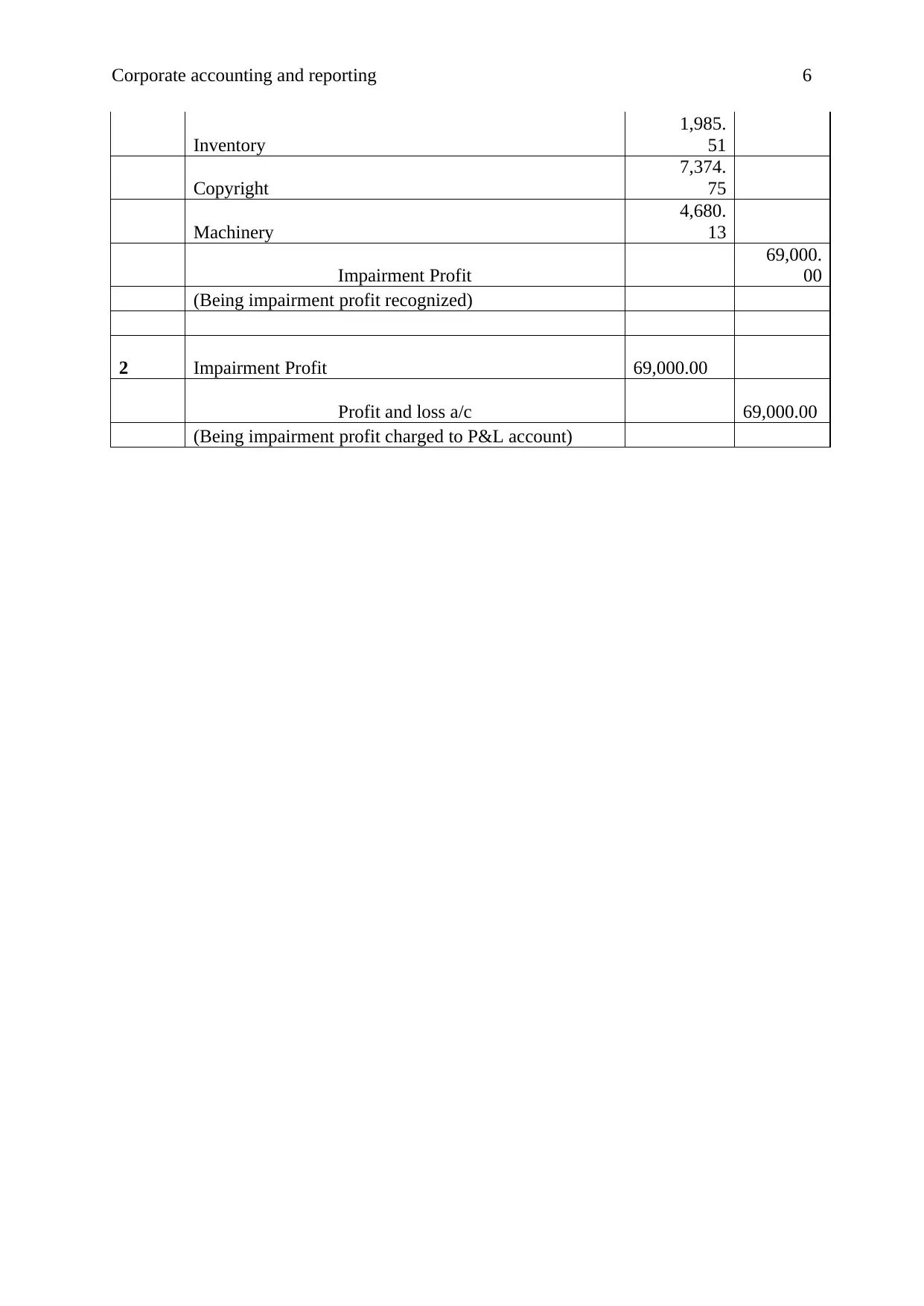
Corporate accounting and reporting 6
Inventory
1,985.
51
Copyright
7,374.
75
Machinery
4,680.
13
Impairment Profit
69,000.
00
(Being impairment profit recognized)
2 Impairment Profit 69,000.00
Profit and loss a/c 69,000.00
(Being impairment profit charged to P&L account)
Inventory
1,985.
51
Copyright
7,374.
75
Machinery
4,680.
13
Impairment Profit
69,000.
00
(Being impairment profit recognized)
2 Impairment Profit 69,000.00
Profit and loss a/c 69,000.00
(Being impairment profit charged to P&L account)
⊘ This is a preview!⊘
Do you want full access?
Subscribe today to unlock all pages.

Trusted by 1+ million students worldwide
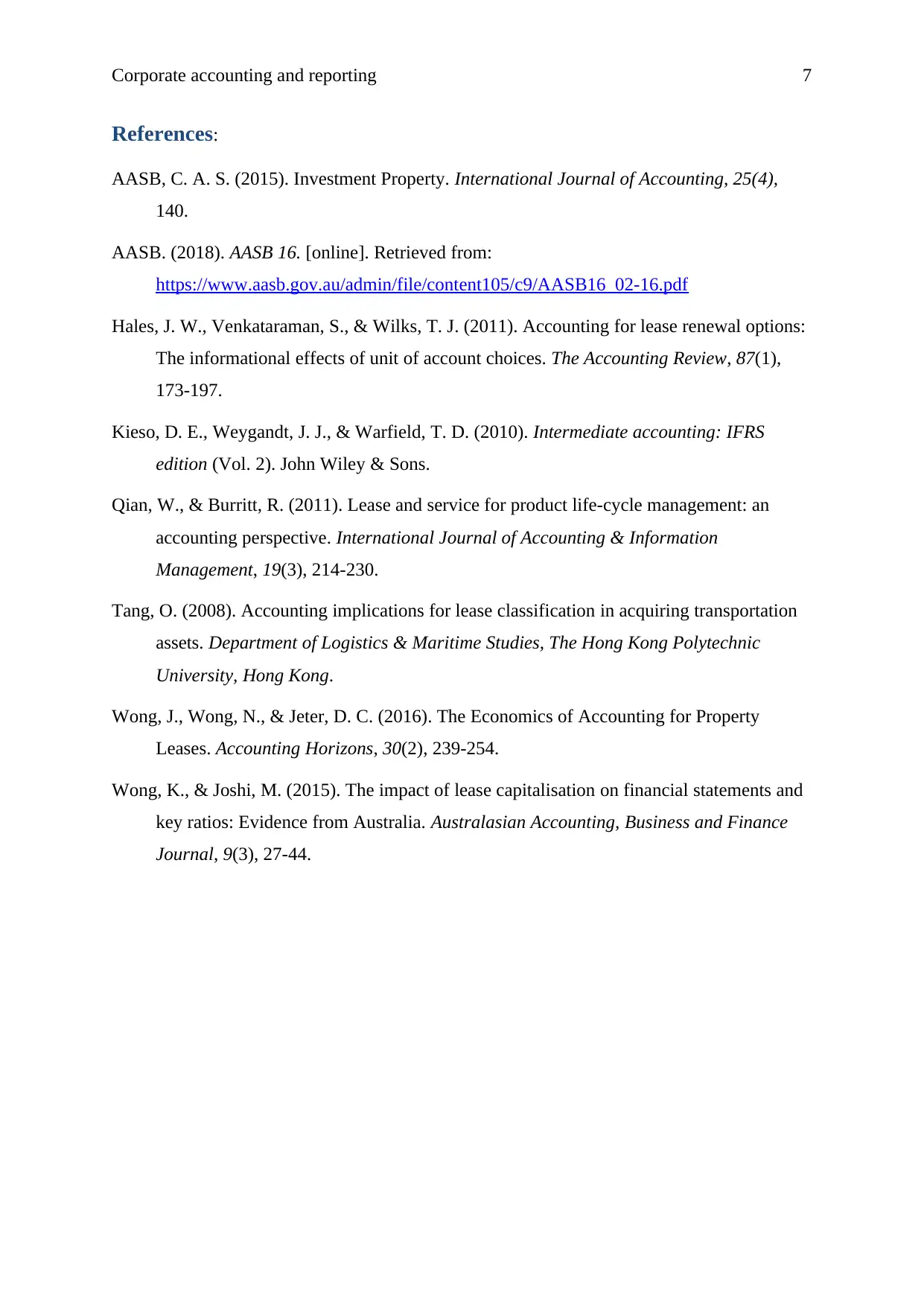
Corporate accounting and reporting 7
References:
AASB, C. A. S. (2015). Investment Property. International Journal of Accounting, 25(4),
140.
AASB. (2018). AASB 16. [online]. Retrieved from:
https://www.aasb.gov.au/admin/file/content105/c9/AASB16_02-16.pdf
Hales, J. W., Venkataraman, S., & Wilks, T. J. (2011). Accounting for lease renewal options:
The informational effects of unit of account choices. The Accounting Review, 87(1),
173-197.
Kieso, D. E., Weygandt, J. J., & Warfield, T. D. (2010). Intermediate accounting: IFRS
edition (Vol. 2). John Wiley & Sons.
Qian, W., & Burritt, R. (2011). Lease and service for product life-cycle management: an
accounting perspective. International Journal of Accounting & Information
Management, 19(3), 214-230.
Tang, O. (2008). Accounting implications for lease classification in acquiring transportation
assets. Department of Logistics & Maritime Studies, The Hong Kong Polytechnic
University, Hong Kong.
Wong, J., Wong, N., & Jeter, D. C. (2016). The Economics of Accounting for Property
Leases. Accounting Horizons, 30(2), 239-254.
Wong, K., & Joshi, M. (2015). The impact of lease capitalisation on financial statements and
key ratios: Evidence from Australia. Australasian Accounting, Business and Finance
Journal, 9(3), 27-44.
References:
AASB, C. A. S. (2015). Investment Property. International Journal of Accounting, 25(4),
140.
AASB. (2018). AASB 16. [online]. Retrieved from:
https://www.aasb.gov.au/admin/file/content105/c9/AASB16_02-16.pdf
Hales, J. W., Venkataraman, S., & Wilks, T. J. (2011). Accounting for lease renewal options:
The informational effects of unit of account choices. The Accounting Review, 87(1),
173-197.
Kieso, D. E., Weygandt, J. J., & Warfield, T. D. (2010). Intermediate accounting: IFRS
edition (Vol. 2). John Wiley & Sons.
Qian, W., & Burritt, R. (2011). Lease and service for product life-cycle management: an
accounting perspective. International Journal of Accounting & Information
Management, 19(3), 214-230.
Tang, O. (2008). Accounting implications for lease classification in acquiring transportation
assets. Department of Logistics & Maritime Studies, The Hong Kong Polytechnic
University, Hong Kong.
Wong, J., Wong, N., & Jeter, D. C. (2016). The Economics of Accounting for Property
Leases. Accounting Horizons, 30(2), 239-254.
Wong, K., & Joshi, M. (2015). The impact of lease capitalisation on financial statements and
key ratios: Evidence from Australia. Australasian Accounting, Business and Finance
Journal, 9(3), 27-44.
1 out of 7
Related Documents
Your All-in-One AI-Powered Toolkit for Academic Success.
+13062052269
info@desklib.com
Available 24*7 on WhatsApp / Email
![[object Object]](/_next/static/media/star-bottom.7253800d.svg)
Unlock your academic potential
Copyright © 2020–2025 A2Z Services. All Rights Reserved. Developed and managed by ZUCOL.




